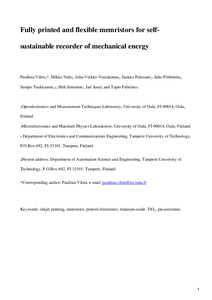Fully printed memristors for a self-sustainable recorder of mechanical energy
Vilmi, Pauliina; Nelo, Mikko; Voutilainen, Juha-Veikko; Palosaari, Jaakko; Pörhönen, Juho; Tuukkanen, Sampo; Jantunen, Heli; Juuti, Jari; Fabritius, Tapio (2016-04-19)
Vilmi, Pauliina
Nelo, Mikko
Voutilainen, Juha-Veikko
Palosaari, Jaakko
Pörhönen, Juho
Tuukkanen, Sampo
Jantunen, Heli
Juuti, Jari
Fabritius, Tapio
19.04.2016
025002
This publication is copyrighted. You may download, display and print it for Your own personal use. Commercial use is prohibited
Julkaisun pysyvä osoite on
https://urn.fi/URN:NBN:fi:tty-201606134229
https://urn.fi/URN:NBN:fi:tty-201606134229
Kuvaus
Peer reviewed
Tiivistelmä
Memristors have attracted significant interest in recent years because of their role as a missing electronic component and unique functionality that has not previously existed. Since the first discoveries of the existence of memristive materials, various different fabrication processes for memristors have been presented. Here, a simple additive fabrication process is demonstrated where memristors were deposited on a polymer substrate by conventional inkjet printing. The memristor structure was printed on a 125 μ m thick polyethylene terephthalate (PET) substrate by sandwiching a thin layer of TiO x between two silver nanoparticle ink electrodes. Current–voltage ( IV ) characterization measurements were performed and they showed clear memristive behavior when voltage pulse amplitude varied between −1.5 V and 1.5 V. The corresponding resistance change is approximately between 150 Ω and 75 kΩ. In order to demonstrate the switching scheme in practical application, printed memristors and a printed voltage doubler were connected with a piezoelectric element. The element was subjected to impact-type excitation thus producing an electric charge that was able to switch the memristor between high and low resistive states. These results pave the way for an exploitation of cost-efficient, self-sufficient, all-printable memory elements for wide utilization in future electronics applications.
Kokoelmat
- TUNICRIS-julkaisut [17085]
